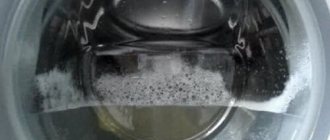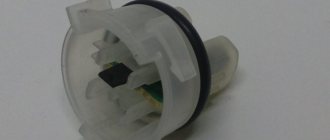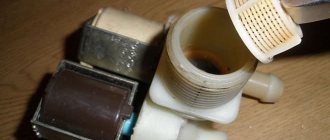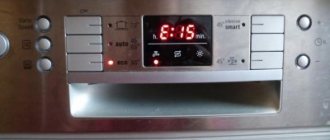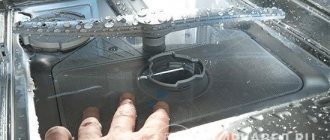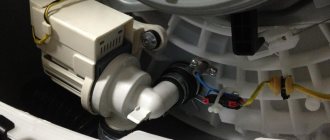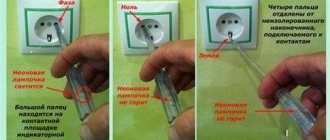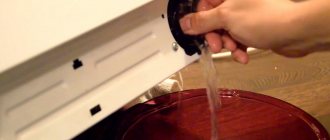Most owners are sure that it is impossible to repair large household appliances without the help of qualified technicians; for example, it is unlikely that they will be able to find out why the dishwasher does not fill with water or the causes of the problem. This is partly true - only specialists can handle complex damage.
Before you start repairing your dishwasher, read this article
In this article we will tell you how to localize and eliminate one of the common malfunctions of a dishwasher (hereinafter also referred to as PMM, dishwasher) without resorting to the services of a technician.
Checking the correct use of the dishwasher
Often the cause of many malfunctions is failure to follow the manufacturer's instructions for operating the equipment. It is important to check that the dishwasher is being used correctly. First of all, you should make sure that there is water flowing into the tap. In apartments, water is supplied to the kitchen by one riser. If there is no water coming into the faucet, the dishwasher will not get any water either. Interruptions in the water supply often lead to temporary problems with the dishwasher.
It is important to use a suitable and high-quality detergent. The use of low-quality household chemicals can lead to serious malfunctions of the dishwasher. Usually the manufacturer gives recommendations regarding the choice of detergents.
The water supply valve may be closed. The mechanism is located at the point where the device hose connects to the water supply system. When the tap is closed, the equipment cannot draw water, so it must be opened.
What caused the problem
This problem is typical for all PMM models: Ariston, Indesit, Veko, Siemens and others. Why doesn't water fill or flow into the machine? Let's look at typical problems that a user may encounter:
- Lack of water in the water supply. It's that simple. There might be a shutdown notice on your door, or maybe there's a problem. Turn on the bathroom faucet and test your guesses. If everything is in order with the water supply, then proceed to the next step.
- The hopper door is not fully closed. If the blocking does not work, water intake will not begin. Press the door firmly until it clicks, after which feeding should resume.
- The shut-off valve is closed. If water does not flow, check the valve located on the water pipe. It serves for emergency shutdown in case of an emergency. It may have been blocked - then unscrew it.
- The inlet hose is kinked. It could be pinched or bent, which impedes the flow. Restore the hose to its normal position.
- Weak pressure. This happens when there is not enough pressure in the system to enter the dishwasher. All that remains is to wait until normal supply resumes.
Have you checked everything point by point, but there is still no water supply? So it's not a matter of minor problems. We will tell you what to do in this case and how to deal with the breakdown.
Troubleshooting water supply problems in the dishwasher
Most simple problems with the water supply to the dishwasher can be fixed at home without the involvement of professional craftsmen or the use of special tools. First of all, you should diagnose the device to determine the cause of the malfunction. Based on the identified causes, certain actions are taken to eliminate them.
Note! If you cannot repair the dishwasher yourself or you do not have experience working with such equipment, you must use the services of a professional technician. Otherwise, the situation may worsen.
Flow hose clogged
Tap water has two key characteristics - softness and degree of purification. If there are foreign objects (rust, etc.) in the water, the filter may become clogged. If the water is of poor quality, this situation will occur with a certain frequency. If the dishwasher valve is clogged, the pressure intensity first decreases, and then the water stops flowing altogether.
For reference! To avoid such problems in the future, you should install a special mesh filter for mechanical cleaning. It will protect the system from impurities and large particles.
To fix problems you need to:
- Turn off the water supply and unscrew the supply hose.
- Find a filter in the form of a fine mesh. Usually located at the point where the hose is attached to the unit.
- Clean the mesh with a needle. For better cleaning, place the filter in a citric acid solution for a while. Usually one hour is enough for cleaning using this method. The solution must be hot.
Fill valve failure
If the supply valve fails, the flow of water into the dishwasher stops. Under certain conditions the valve may stop opening. The malfunction is often caused by pressure surges in the plumbing system. The reason may also be voltage fluctuations. It is impossible to repair the valve; damage can only be eliminated by replacing the unit. Without the appropriate skills, it is not recommended to change it yourself; it is better to turn to professionals.
Failure of the pressure switch (water sensor)
When such a breakdown occurs, the dishwasher usually makes noise, but no water is drawn in. The pressure switch is responsible for determining the water level. If it malfunctions, the control unit receives incorrect readings. The device increases the time it takes to collect water, resulting in overflow.
If the water supply indicator is active, but there is no flow, the sensor has failed. The pressure switch cannot be repaired; replacement is necessary, as follows:
- Disconnect the device from the electrical outlet and water supply. Turn the car over on its side.
- Remove the bottom cover, if present.
- The pressure switch is made in the form of a plastic box. Using pliers, remove the tube from the assembly.
- Unscrew the screws securing the sensor and remove it. Check for blockages.
- Using a multimeter, measure the resistance across the contacts. This will allow you to determine the health of the unit.
- Install the new sensor by following these steps in reverse order.
Control unit malfunction
Almost all processes in the dishwasher are controlled by the control unit. If a node malfunctions, various malfunctions occur in the functioning of the device, up to complete inoperability. It is impossible to repair the module yourself. It is necessary to contact a specialized service, preferably recommended by the manufacturer.
You can only diagnose the problem yourself. To do this, you need to open the camera door and unscrew the screws. The control module is made in the form of a board. The assembly should be examined for external defects. If burnt wires or tracks, oxidation, or leaks are detected, the problem is most likely in the block.
Triggering of the Aquastop system
Not all dishwashers are equipped with such a system. It is a special valve that prevents an accident in the event of a leak. The safety valve must also be replaced and cannot be repaired. To replace you need:
- Turn off the water and disconnect the hose.
- When the valve is pressed tightly against the edges of the hose, the breakdown occurs in this unit.
- Remove the valve and install a new one.
More complex faults cannot be corrected on your own. But you should at least try to make a diagnosis. Further measures are determined based on the nature of the malfunction.
Household appliances Dishwasher
Does the list of factors change depending on the dishwasher model?
The list of reasons is the same for all brands and models of dishwashers because they work on the same principle.
Only design features may differ slightly, for example, the presence of a mesh in the filter or the mechanism of the Aquastop system. However, dishwashers may display an error code indicating that water cannot be supplied.
Each manufacturer usually has its own:
- Bosch – E3/E8;
- Beko – 0000;
- Electrolux – i10, iA0;
- Indesit – Al02;
- Hansa, Samsung – E1;
- LG–IE.
The code only indicates the presence of a problem, not a specific malfunction. Therefore, in any case, inspection and diagnosis of the machine is necessary.
What preventative measures should be taken?
Prevention methods:
- use of special steel to prevent corrosion;
- the use of high-quality dishwashing detergents that do not contain chemicals that damage the internal structure of the PMM;
- Before installing the dishes, all food residues are carefully removed;
- It is not recommended to install dishes with strong burning (they are pre-soaked to remove particles);
- Periodically clean the filter with water and soapy water to prevent excessive contamination.
These methods will help you use your dishwasher for many years without any problems.
Built-in and free-standing models
The manufacturer Miele offers built-in and free-standing dishwashers. The first ones are attractive because they look organic in any interior. Since they are invisible from the outside, they attract less attention from children. Free-standing ones are cheaper, and such models also help out if you decide to buy a dishwasher when the renovation is already complete and there is no niche for installation.
In any case, it is necessary to select equipment for the characteristics of the room, taking into account the available space for installation. The Miele line includes both built-in and freestanding dishwashers with a width of 44.8 cm and a depth of 57 cm.
Typical problems with the Hansa PMM
To understand the reasons for the breakdown, knowledge about the principle of operation of the dishwasher will be useful. Let us briefly and clearly describe the sequence of stages:
- Loading dishes, turning on the program.
- Switching on the solenoid valve, water intake.
- Pumping water with a circulation pump through a heating element, heating it.
- Hot liquid is fed into the spray nozzles and flies out of the nozzles under pressure.
- The waste liquid goes into the drain filter, where it is cleaned and can be reused.
- After rinsing is completed, the water goes down the drain.
- Drying starts or the cycle ends.
Why does the car fail? There are several main reasons:
- Poor build quality. Manufacturing defects.
- Unstable voltage in the network, which leads to damage to electronics.
- Incorrect installation and connection of the PMM.
- Using low-quality detergents.
- Operational problems.
A common problem is blockages in the drain and fill paths. Hence the problems with collecting or draining water. Poor cleaning of dishes before loading leads to foreign objects entering the filter and pump.
What problems are typical for Hansa dishwashers? In first place, according to the service centers, was a malfunction of the pressure switch, or more precisely, its electrical part. Users also complain about the following:
- The machine does not turn on;
- Very bad at washing dishes;
- The body is electrocuted;
- Noise during operation;
- Poor supply of detergent.
In addition, error codes on the display can indicate a breakdown.
Water level sensor
What kind of sensor is this? Experts call it a pressure switch. This is an electronic sensor that measures the level of water pressure and transmits information to the control module. Next, the module, after analyzing the information received, decides how much water is needed for each cycle of operation of a particular dishwasher program.
If this sensor fails or does not work correctly, then signals to the control module may either not be sent at all or arrive incorrectly. This is another reason why your dishwasher won't fill with water. Replacing the sensor with a new one will help correct the situation. This operation at the service center will cost about one and a half thousand rubles.
Device structure
Before you figure out why the Bosch dishwasher has problems with water, you need to study how this device works
You should immediately pay attention to the fact that the design of the device is not simple. The manufacturer recommends that you perform only a few actions yourself: cleaning filters from contamination and additional settings
In other cases, it is recommended to contact the service center with all problems. But if the owner of the dishwasher has certain knowledge, then you can try to do the repair yourself. To do this, you need to know on what principle the device works. During one dishwashing cycle, several actions are performed:
- Pre- and main wash.
- Rinse.
- Drying.
In order for the device to work, it must be connected to the mains. After this, water is withdrawn. This action is performed automatically. The water passes through a special salt softener to prevent scale formation. Then it penetrates into the car under pressure through the inlet valve. The amount of water is adjusted using a special float. The dishwasher also has a pressure switch. It is designed to turn off the water pressure when its level has reached its maximum level. Only after this does heating begin and the dishwashing itself begins.
Door fault
The door of any car is always equipped with a special locking mechanism. It serves to protect against possible leaks. If the locking assembly fails, the machine will not be able to begin the washing cycle and a malfunction will occur when the unit cannot draw water.
To correct the situation, it is necessary to repair or replace the locking device. In service centers, this operation will cost a thousand rubles. If it is possible to purchase the required original spare part and you have certain skills in repairing household appliances, then you can perform the replacement yourself.
Tank leak
If your dishwasher fills with water and immediately drains, the problem is most often due to a leak in the machine's tank. When collecting liquid, the bulk of the units control that it does not leak out. The pan of the machine is equipped with leakage sensors. As soon as water gets on the sensor, even in a minimal amount, the machine will stop working or will not start. Units equipped with displays may display error numbers.
You can fix such breakdowns yourself. If the cuff is worn out or the clamps on the pipes are loose, then this can be easily changed with your own hands. If the hoses and pipes are out of order, this can also be fixed with your own hands.
"AquaStop"
Models of cars may be different, but the reasons for breakdowns are the same for all. But some more modern models have the AquaStop system. What it is? This is a kind of protection against unauthorized leaks. The hose through which liquid from the water supply is supplied to the dishwasher is covered with a special protective casing. In the event of an emergency, the system itself will shut off the fluid supply to the unit. This protective system can be triggered by various faults. As a result, the dishwasher does not draw water. This option also does not need to be excluded when diagnosing a household unit.
Video
We invite you to watch a video about eliminating the reason why the BoschEdition 45 SilencePlus dishwasher does not fill with water:
Electronic engineer with many years of experience. For several years I was engaged in organizing the repair of household appliances. I am glad to share with readers my knowledge in the field of operation and repair of devices. Loves sport fishing, water tourism and travel.
Found a mistake? Select the text with the mouse and click:
The dishwasher cleans more than just plates and cups. You can load it with plastic toys, glass lamp shades and even dirty vegetables, such as potatoes, but only without using detergents.
Fresh lemon is not only suitable for tea: clean dirt from the surface of an acrylic bath by rubbing with half a cut citrus, or quickly wash the microwave by placing a container of water and lemon slices in it for 8-10 minutes at maximum power. The softened dirt can simply be wiped off with a sponge.
Threads made of gold and silver, which were used to embroider clothes in the old days, are called gimp. To obtain them, the metal wire was pulled for a long time with pliers to the required fineness. This is where the expression “to drag out the rigmarole” came from - “to do long, monotonous work” or “to delay the completion of a task.”
If your favorite things show the first signs of gestation in the form of untidy pellets, you can get rid of them using a special machine - a shaver. It quickly and effectively shaves off clumps of fabric fibers and returns things to their proper appearance.
The habit of using an automatic washing machine “sparingly” can lead to the appearance of an unpleasant odor in it. Washing at temperatures below 60℃ and short rinses allow fungi and bacteria from dirty clothes to remain on internal surfaces and actively multiply.
Stretch ceilings made of PVC film can withstand from 70 to 120 liters of water per 1 m2 of their area (depending on the size of the ceiling, the degree of its tension and the quality of the film). So you don’t have to worry about leaks from neighbors above.
Before removing various stains from clothing, you need to find out how safe the selected solvent is for the fabric itself. It is applied in a small amount to an inconspicuous area of the item from the inside out for 5-10 minutes. If the material retains its structure and color, you can move on to stains.
The easiest way to remove scale and carbon deposits from the soleplate of the iron is with table salt. Pour a thick layer of salt onto the paper, heat the iron to maximum and run the iron over the salt bed several times, applying light pressure.
There are special traps to combat moths. The sticky layer with which they are covered contains female pheromones that attract males. By sticking to the trap, they are eliminated from the reproduction process, which leads to a decrease in the moth population.
A dishwasher is a reliable assistant in any kitchen. Leading equipment manufacturers such as Ariston, Electrolux, Hansa, Bosch, Beko, Gorenje, Indesit, Mile, Merloni, Zanussi, AEG, Ardo and others equip their models with innovations, constantly work to improve product quality, and introduce modern technological solutions into new products. But any equipment needs regular maintenance and repair. Even with the most reliable models, sometimes various kinds of troubles occur: water does not fill, a leak occurs, or water does not drain from the dishwasher. However, today we will talk about a fairly common problem - the dishwasher does not fill with water.
If you notice that for some reason there is no water flowing into the dishwasher, do not rush to call the service center and call a technician. Perhaps the problem is related to blockages or minor faults that can easily be fixed with your own hands.
Intake filter clogged
Just like with washing machines, the dishwasher inlet filter can become clogged with a variety of solid particles. To prevent this from happening later, we recommend installing a filter at the input.
Instructions for cleaning the inlet filter:
- Turn off the water, unscrew the hose and drain all the liquid from it.
- Take pliers and, with precise movements, pull the plastic filter out of the valve, rinse it thoroughly under running water.
- Insert the filter back and connect the hose.
Crack in the tank
Another reason why the machine fills up and immediately drains water is if the tank is damaged. Cracks are a fairly common occurrence, especially in inexpensive cars.
By reducing the price for the consumer, the manufacturer tries to save on everything, including the thickness of the metal for the tank. The wall thickness of some tanks is very small. Even a slight blow can damage the tank.
Recommendations
Most often, these valves fail because a large amount of low-quality, dirty water passes through them. Deposits appear on the internal parts. As a result, it does not work correctly. It is recommended to install a filter on the water supply.
This will help extend the life of the valve and other machine components. The cost of these cleaning systems may vary. But, as a rule, a high-quality system for cleaning water pipes will cost at least ten thousand rubles.
